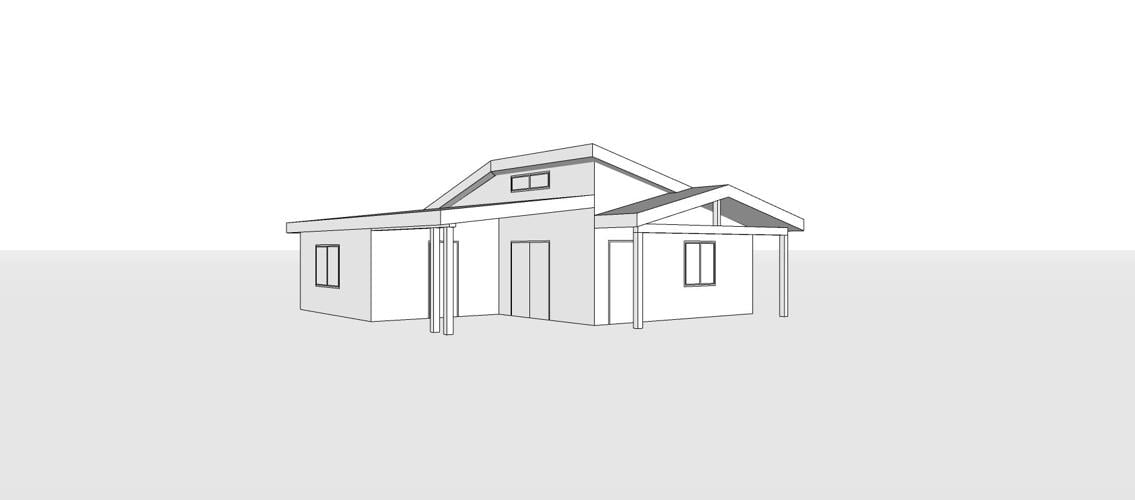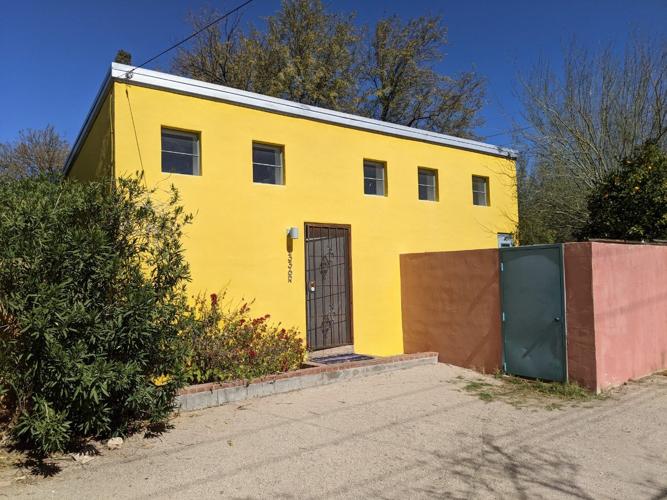With the goal of helping build 1,000 new homes in the next year, two Tucson business partners have combined their collective skills.
The Urban Infill Project provides pre-permitted accessory dwelling unit designs (known as ADUs) to simplify the process for homeowners wanting to add a home on their property for an aging parent, a child in college or for additional income.

A model of a one-bedroom, 825-square-foot accessory dwelling unit offered by the Urban Infill Project.
Cofounders Valerie Lane and Lisa Bowers were introduced by mutual friends.
“We both had unexpressed passion for how to help the community grow,” said Bowers, who has worked as a development liaison for 20 years.
She brought the expertise on how to navigate the city and county with plans and permits and knows the bureaucracy.
“I’ve developed the relationships over 20 years and know the most efficient way to get this done,” Bowers said. “And how to get in front of the right people.”
Lane, an architect and teacher of construction and building technology at the University of Arizona, is the perfect complement.
“Valerie brings creativity and design to it,” Bowers said. “Many people will use the ADU for intergenerational living and she understands how people move around the home.”
Whether it’s a large yard or a vacant lot, property owners can use the duo’s service to erect an ADU.
They have seven pre-permitted design drawings that will receive expedited approval from the city of Tucson or Pima County, through the arrangement they have negotiated.
Currently, Tucson and unincorporated Pima County are on board. Urban Infill is working with the towns of Marana, Oro Valley and Sahuarita, along with Santa Cruz County to adopt the model in those jurisdictions.
Homes range in size from a 605-square-foot studio to a 1,000-square-foot, two-bedroom model.
“If you hire an architect to draw up a custom design, it can take three to six months to get a permit,” Lane said. “Using our process, you can have a permit in a month.”
Construction is set to begin on Urban Infill Project’s first two ADUs at a home in the Broadmoor-Broadway neighborhood, near Broadway and Country Club Road.

A car drives past a home where two accessory dwelling units will be built in the Arroyo Chico Neighborhood in Tucson on July 26. Two local businesswomen have started a business to help expedite the approval of accessory dwelling units in Tucson and Pima County.
The pre-permitted drawings range in price from $3,500 to $4,800 — about half of the cost to hire an architect for a custom design.
The cost of building an ADU in the Tucson market is estimated at between $200 and $250 per square foot, and the addition can increase the property value up to 30%.
No single solution
Although Urban Infill Project sells the permitting process and referrals and are not themselves builders, Lane and Bowers wanted to get their name out in the community and recently became members of the Southern Arizona Home Builders Association.
“Tucson simply doesn’t have the housing supply we need to support our current and future population (and) that’s caused issues with housing opportunity, housing access and housing affordability,” said David Godlewski, president of SAHBA. “In order for us to address these challenges, and to have a healthy housing market, we need a full range of housing types from ADUs to high-end homes.”
He called the Urban Infill Project key to helping homeowners and contractors navigate the rules for ADU construction.
“SAHBA recognizes there is not one single solution to building enough inventory,” Godlewski said. “We are determined to support the variety of businesses and promote a range of policies that are needed.”
In 2021, the City of Tucson voted to allow casitas to be built on residential property and has made tweaks since then, such as allowing utilities to be shared with the primary home and not having to meet the requirements for solar, greywater and electric vehicle charging as is the case for new construction.

Tucson has adopted zoning allowing such units alongside existing single-family homes. The Urban Infill Project wants to make the process easier for homeowners.
The city recently launched a “casita model plan design” competition and will select up to 10 designs to be showcased on the Casitas in Tucson online gallery and have the permit fees for review and approval waived.
An attractive option
The housing shortage in the Tucson area — and nationwide — has brought renewed attention to ADUs, whether it’s a converted garage, basement or a new build.
“A fed-up public is now realizing that local constraints on building housing and resulting high prices and rents have plagued the United States’ most productive regions for decades,” according to Emily Hamilton, a senior research fellow and director of the Urbanity Project at the Mercatus Center at George Mason University. “From an affordability perspective, ADUs are an attractive reform option because these units can rent for hundreds of dollars less than apartments in the same neighborhood.”
States with high rates of older residents are experiencing the largest growth in ADUs.
“Are ADUs the right approach for legalizing more housing everywhere? They have much to offer,” Hamilton said. “Because many homeowners can see themselves wanting the right to add an income-generating or relative-accommodating ADU to their property at some point, they may be the least contentious way to create opportunities for more housing within existing residential neighborhoods.”
Aside from adding more housing in the Tucson area, the Urban Infill Project is passionate about building in areas that are already developed.
“I am dedicated to housing issues and urban infill,” Lane said. “I feel very passionately that we have a lot of lots to work with within the city and building on the outskirts is irresponsible.”






